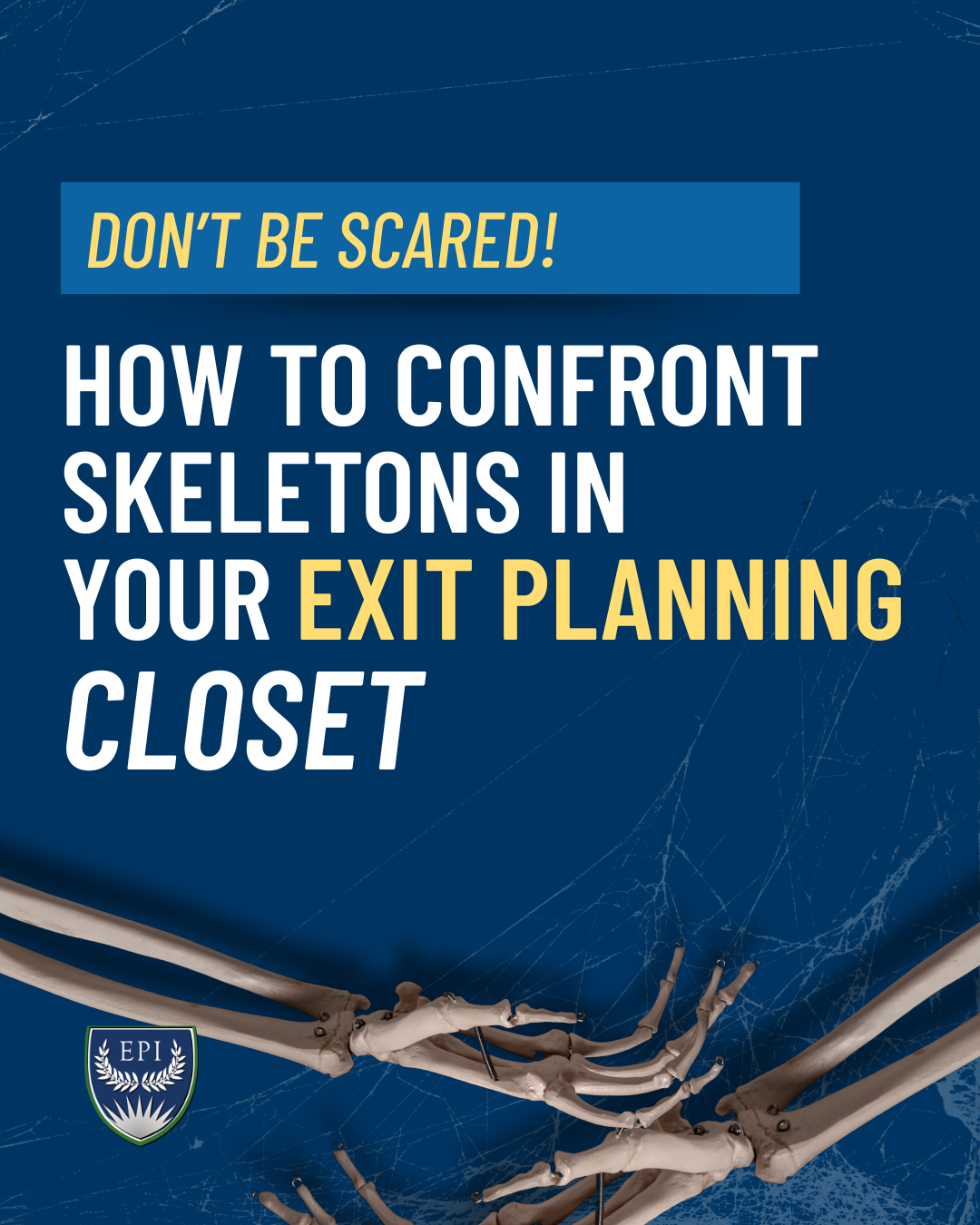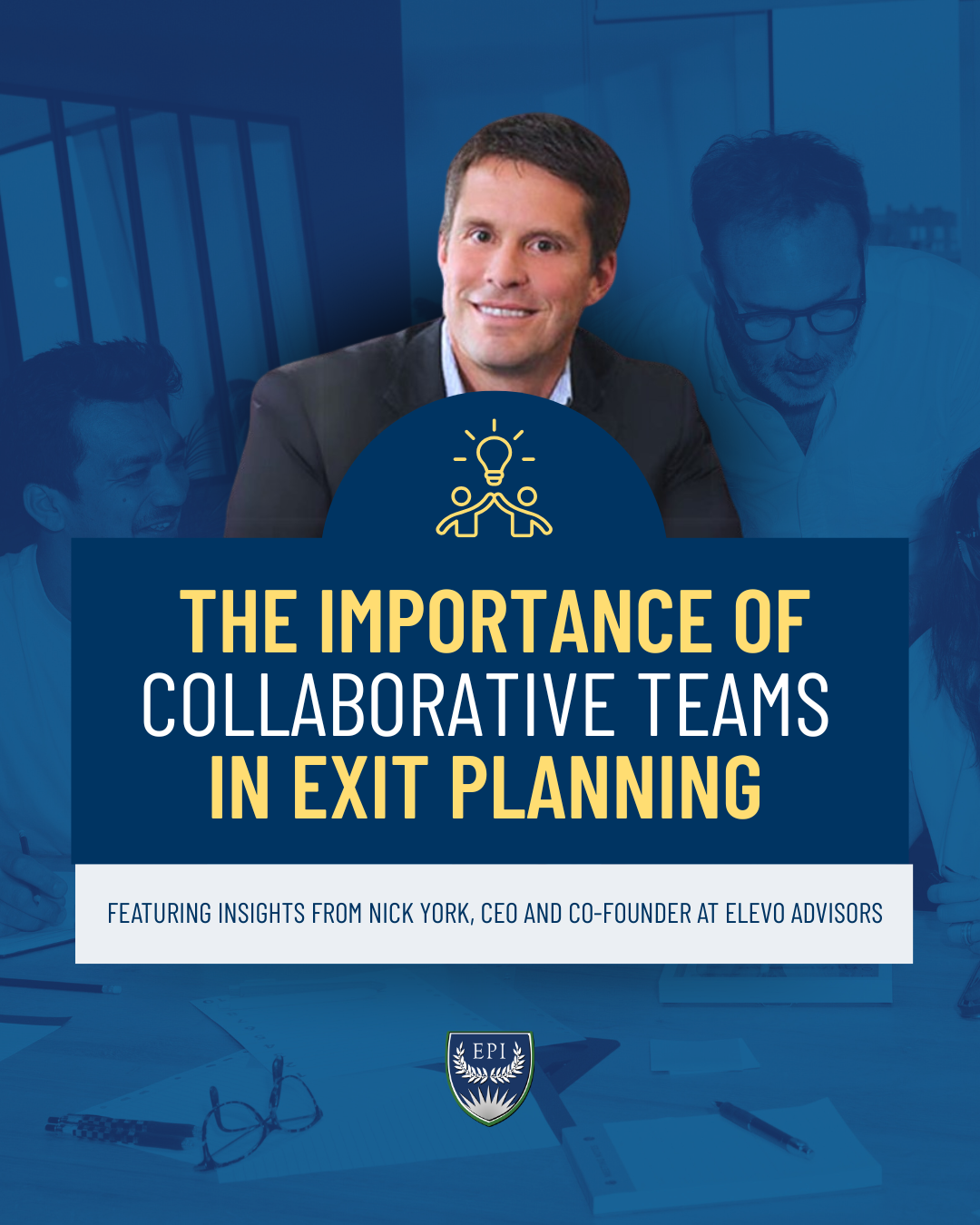
THE EXIT PLANNING BLOG
Keep up-to-date with exit planning, succession planning, industry trends, unique specialty insights, and useful content for professional advisors and business owners.
Share this
Don’t Be Scared! How to Confront Skeletons in Your Exit Planning Closet
by Kellie Nock on October 30, 2025

Don’t Be Scared!
Business owners face a lot of frights every day. From tax planning to legal issues, employee turnover, market uncertainty, and more, there is no shortage of spooky situations that owners confront on every step of their journey. With all the different hats, it comes as no surprise that, when the time comes, owners might feel they have a few exit planning skeletons in their closet.
As scary as Halloween is, nothing is quite so frightening as confronting the business exit. Luckily, with the guidance of a Certified Exit Planning Advisor (CEPA®) harnessing the power of the Value Acceleration Methodology™ (VAM), owners can fully confront exit planning skeletons in their closet to achieve the exit of their dreams, not their nightmares.
A core concept within VAM is the Three Legs of the Stool, or the alignment of the owner’s personal, business, and financial goals, for holistic value growth and the desired exit. Each leg (business, personal, and financial) encompasses different elements of the owner’s life and work, and with it, any complications that those entail. Read on to discover how to clean out the closet for each respective leg of the stool.
Pumpkin Patch of Personal Planning
Often overlooked in the busyness of day-to-day business operations, the personal leg of the stool covers personal planning and personal financial planning. It asks the owner to define their personal purpose. Owners spend much of their lives building up their business and shouldering many burdens so that, when the time comes, they can exit the business with more income and achieve their financial goals.
It can be scary then, the day after the exit finalizes, and they lose a sense of purpose. Maybe they’re not going into the office every day anymore, or maybe they have more free time than they know what to do with. Whatever the case, this unfulfilled personal purpose can lead to a deep sense of regret for owners.
For this, Christopher Snider, CEO of the Exit Planning Institute® (EPI) and author of the Value Acceleration handbook, Walking to Destiny, recommends the S.T.E.P. exercise. This means taking a deeper look into each of these aspects, and focusing on what really matters to you in each:
- Spiritual
- Things
- Experiences
- People
Core to the personal planning leg is also personal financial planning. This element of VAM helps the owner close their Wealth Gap, which is their Wealth Goal minus their current net worth, not including their business value. This Wealth Goal provides structure post-exit, according to Christopher.
“Your Wealth Goal should reflect how much money you need to accomplish your Personal Plan without the income from the business. This is one reason it is imperative you have a written Personal Plan for what comes next after your exit,” he writes. “It is simply impossible to do appropriate financial, estate, and tax planning if you do not have a written plan for what you will do after you exit your business.
So, a good personal plan:
- Is documented
- Acknowledges the Wealth Gap
- Recognizes purpose
A Not-So-Frankenstein Financial Plan
Perhaps scariest of all is the idea of financial skeletons in the exit planning closet. No one wants to deal with market fluctuations, loans/debt, tax snags, or any of the other risks present in the financial leg of the stool.
By adhering to VAM and creating recorded, repeatable, and transferable Structural Capital (one of the 4Cs), the business is much better positioned to get ahead of due diligence and tax planning. Also, the business owner’s exit planning team should be led by a CEPA, who, in many cases, can also act as the financial advisor (FA), and if they’re not the FA, they can find the right fit for the business owner. Being the quarterback and CEPA means being able to connect the dots for owners and find the right person for the right job in each stage of VAM.
For further insights on the financial leg of the stool, EPI Academy has a plethora of courses that not only provide deeper dives into all things VAM but are also available for EPI continuing education credits and, in some cases, the CFP® Board and the National Registry of CPE Sponsors.
No Boos Business Plan
Aligning the business leg of the stool asks the owner and the CEPA to create actionable strategies in the business to bolster the 4Cs, as mentioned earlier. These include:
- Customer Capital – the strength of the customer relationships the company has, regardless of leadership or personnel changes
- Social Capital – the strength of the culture and organized identity of the company
- Human Capital – the strength of the people in the company and their ability to execute the purpose and vision of the business
- Structural Capital – the strength of the strategy, systems, and processes in the business
Putting time, energy, and resources into strengthening these intangible capitals builds a stronger foundation for the business plan and further accelerates value in the business. Aligning the business goals also includes de-risking and decentralizing the owner from the business. Creating a sturdy engine powers the ongoing VAM journey and positions the owner for a more prolific and more desired exit.
No Tricks, Just Treats
With more than 80% of the owner’s wealth tied up in the business, it can feel very spooky to know that exit is on the horizon, and some ghouls haven’t been cleaned out yet. Working with the CEPA to align the Three Legs and follow VAM guarantees a scare-free exit planning process and a satisfying third act.
Related Resources
Share this
- Blog (545)
- CEPA (420)
- exit planning (249)
- CEPA community (187)
- Business Owner (169)
- Exit Planning Summit (95)
- EPI Chapter Network (89)
- Value Acceleration Methodology (79)
- Exit Planning Partner Network (76)
- EPI Announcement (49)
- Content (48)
- Webinars (37)
- Excellence in Exit Planning Awards (33)
- Marketing (30)
- 2024 Exit Planning Summit (28)
- 5 Stages of Value Maturity (26)
- Books (24)
- EPI Academy (24)
- Exit Planning Teams (22)
- EPI Team (21)
- Leadership (21)
- 2023 Exit Planning Summit (20)
- family business (20)
- women in business (19)
- Intangible Capital (18)
- Exit Options (17)
- Black Friday (16)
- CPA (15)
- Walking to Destiny (15)
- State of Owner Readiness (14)
- Chapters (13)
- Chris Snider (12)
- National Accounts (12)
- Small business (12)
- charitable intent (12)
- personal planning (12)
- Financial Advisors (11)
- Season of Deals (9)
- 5 Ds (8)
- About us (8)
- Podcast (8)
- Insiders Bash (7)
- Scott Snider (7)
- Christmas (6)
- Exit Planning Content Library (6)
- Case Studies (5)
- Owner Roundtables (5)
- Value Advisors (5)
- financial planning (5)
- Awards (4)
- Circle of Excellence (4)
- Exit & Succession (4)
- Five Ds (4)
- Three Legs of the Stool (4)
- executive training (4)
- Owners Forum (3)
- author (3)
- forbes (3)
- DriveValue (2)
- EPI Thought Leadership Council (2)
- Exit Is Now Podcast (2)
- Peter Christman (2)
- Veteran (2)
- Whitepapers (2)
- Business Owners Forum (1)
- SOOR (1)
- business consultants (1)






